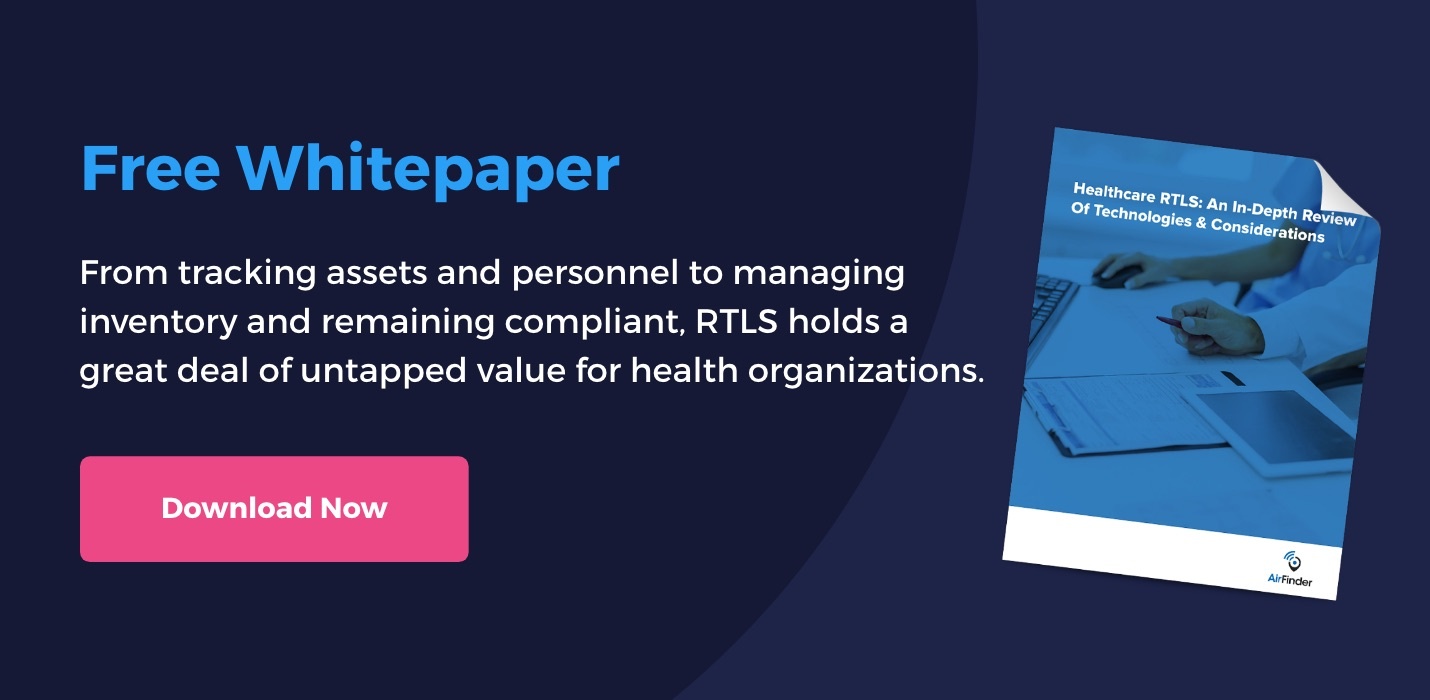If you use AirFinder for your healthcare real-time location tracking (RTLS) application, you’ll benefit from the following:
- A simple, stress-free integration: When you’re piloting a new technology, IT can be a barrier—and for a good reason. Every additional technology added to your network (or your customers’ network) can pose a potential security risk. However, Link Labs’ AirFinder doesn’t touch your network in any way (and can be backhauled via cellular).
- A low cost, scalable solution: AirFinder doesn’t require a huge upfront investment; it can scale all the way from one location to 10,000 locations. You can start small and build from there. We’ve seen healthcare centers start using AirFinder in operating rooms only, then later scaling through the hospital as needed. Or, if you wanted to study patient/provider interactions, you could track only the providers in the research study.
- A lightweight, inexpensive install: Why pay for an infrared or ultra wide-band (UWB) install that could run tens of thousands of dollars when you can install a Bluetooth-based system for a fraction of that cost? This means more profit if you’re integrating AirFinder technology into your solution, or increased ROI if you’re installing AirFinder in your healthcare facility.
But if you’re not quite ready to build out your healthcare RTLS, it’s not a problem. You may want to do some additional research to find the solution best-suited for your needs. Take the following six things into consideration before you select a hospital RTLS.
6 Things To Consider When Choosing RTLS For Your Hospital
1. Is the solution within your budget?
- Tag costs: A $50 price tag may not seem unreasonable, but if you need 5,000 tags, you may run into some budgetary constraints. Additionally, some solutions force you to use proprietary tag technology, which will definitely up the cost.
- Power consumption costs: Consider how much power each tag or access point will draw and whether your system (or your customer's system) can handle it.
- Labor costs: If someone has to create an elaborate map to integrate your RTLS technology, you’re going accrue more labor costs.
- Integration costs: Integrating an infrared RTLS solution will require a great deal of work. You will have to install a tag reader in the ceiling of every room in the network and hardwire those readers back to a central access point. Of course, running cables and power through the ceiling of every room can be very disruptive and difficult to do.
2. How complex is the IT integration?
Working with the IT department to implement a new solution typically involves filling out a lengthy security questionnaire and waiting 3-6 months for approval. Some RTLS solutions—like AirFinder—require no IT integration whatsoever. Keep this in mind when crafting or purchasing a solution.
3. How much of the facility will you need to outfit?
If you’re only tracking 10 items in five rooms, integrating an extensive infrared RTLS solution may be wasteful. Carefully consider what you want to track and how much of your hospital or health care system will be affected before choosing your solution.
4. Do you need exact locations or proximity?
Does it matter if your asset tracking solution can triangulate the exact position of a tracked item, or do you just need to know a general location of an item?
5. What do you want to track?
If you’re tracking expensive capital assets, like an infusion pump or X-ray machine, spending $80 on an RTLS tag is reasonable. But if you need to locate Dr. Bob’s special surgery stool (so his interns stop wasting time searching for it), or if you want to track 1,000 pillows around the hospital, a $2 price tag meets the use case more appropriately.
6. Do you need to track outside the traditional clinical environment?
If you need to track staff visiting patient homes, or the location of hospital vehicles, you’ll want to be certain your technology does well with multi-mode tracking. AirFinder can use a combination of cellular and GPS to track a team of home health aides carrying medical equipment from home to home, but a system like WiFi wouldn’t work as well in these conditions.
Free White Paper
For more information on healthcare RTLS, download this free 11-page white paper. In it, we’ll discuss benefits and considerations for the six main types of RTLS technology, and an in-depth look at why AirFinder may be a good solution for you. Fill out this form to get your free copy today.





